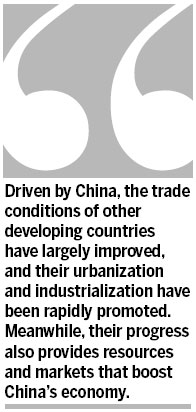Double-engine economy
Updated: 2013-06-03 08:20
By Jiang Hong (China Daily)
|
||||||||

China plays an important role in linking developed economies with developing ones and contributing to world growth
For a long time the developing economies in Asia, Africa and Latin America were economically dependent on developed countries. With many restrictions imposed on their independent development, the developing countries were in a disadvantaged position in the international division of labor and industrial chain. The developing economies mainly provided resources and markets for the developed world with the developed economies having great economic influence over developing economies.
One of the key characteristics of such an economic system was that the Western world exerted a strong impact on the world economy, when it enjoyed normal development, the world economy developed normally, but when it experienced recession or crisis, the effects would be transferred to other countries.
The financial crisis, beginning in 2007, originated from the United States, then rapidly spread to other countries and global financial markets, even causing severe turmoil in the development of the global real economy.
But since the start of this century, emerging economies have become increasingly important in driving global economic growth, and some significant changes have taken place in the global economy. The single-cycle system driven by the US has gradually evolved into a dual-cycle one, with China, as the largest representative of emerging economies, playing a pivotal role as a second economic engine.
Great changes and restructuring happened in the global economic and political system after the financial crisis. With the economic strength of emerging economies rising, the balance between developing and developed economies has gradually changed. While the US' role as the driving force of the global economy has been weakened and the developed countries share of the global economy has declined, the emerging economies' contribution to the global economy has increased rapidly.
In 2010, for the first time, the developing and emerging economies' capital influx accounted for more than 50 percent of the global foreign direct investment, reaching 51.6 percent. In 2012, for the first time in modern history, China surpassed the US as the largest trading country. In its latest World Economic Outlook released in January, the International Monetary Fund predicted the growth of global GDP would be 3.5 percent this year, with the developed economies increasing by 1.6 percent and the emerging economies by 5.5 percent.
The global economic system has become a dual-cycle economic system, as China has already become a significant engine for global economic growth and also actively participated in the building of the global economic order.
There is a circular system between China and the developed countries, including industrial division, trade, investment and capital inflows, and China has built a circular economic system with developing countries through trade and direct investment. The two systems are not separate, as China links both together.
A dual-cycle economic system with two engines can maintain the smooth operation of the global economy, even when the US engine "breaks down". That's why the emerging economies can keep strong growth, despite the financial crisis causing recession and slowdowns among developed countries.
In a dual-cycle global economic system, China, as a hinge linking both the developed and developing economies, can realize the "rebalancing" of the global economy. Specifically, the developed countries need China's huge market and strong manufacturing capacity, and the mature industrial system in China can help more developing countries to realize re-industrialization, since many of them still cannot meet the investment needs and requirements of high-tech from developed countries in the short term.
China cooperates well with other developing countries in Asia, Africa and Latin America, which means they are very complementary in development. China can also realize its industrial upgrading and structural adjustment through the process of promoting other developing countries' development. As the world factory, China not only provides products for Western countries, it also offers made-in-China goods to other developing countries. Driven by China, the trade conditions of other developing countries have largely improved, and their urbanization and industrialization have been rapidly promoted. Meanwhile, their progress also provides resources and markets that boost China's economy.
Now China has a key position in the dual-cycle world economic system, it must carefully deal with some relationships when realizing its own development. Not only should it carefully deal with the "vertical competition" with developed countries, it should also better handle the "horizontal competition" with developing countries at a similar development level as China. More importantly, China should carefully manage the "relevant competition" with those developing countries which have a relatively lower development level compared to China. Although there may be some conflicts, the developing countries should help each other to realize common development in the future.
The author is a researcher and executive vice-president of the Institute of China Development Bank.
(China Daily USA 06/03/2013 page11)

 Michelle lays roses at site along Berlin Wall
Michelle lays roses at site along Berlin Wall
 Historic space lecture in Tiangong-1 commences
Historic space lecture in Tiangong-1 commences
 'Sopranos' Star James Gandolfini dead at 51
'Sopranos' Star James Gandolfini dead at 51
 UN: Number of refugees hits 18-year high
UN: Number of refugees hits 18-year high
 Slide: Jet exercises from aircraft carrier
Slide: Jet exercises from aircraft carrier
 Talks establish fishery hotline
Talks establish fishery hotline
 Foreign buyers eye Chinese drones
Foreign buyers eye Chinese drones
 UN chief hails China's peacekeepers
UN chief hails China's peacekeepers
Most Viewed
Editor's Picks

|

|

|

|

|

|
Today's Top News
Shenzhou X astronaut gives lecture today
US told to reassess duties on Chinese paper
Chinese seek greater share of satellite market
Russia rejects Obama's nuke cut proposal
US immigration bill sees Senate breakthrough
Brazilian cities revoke fare hikes
Moody's warns on China's local govt debt
Air quality in major cities drops in May
US Weekly

|

|







